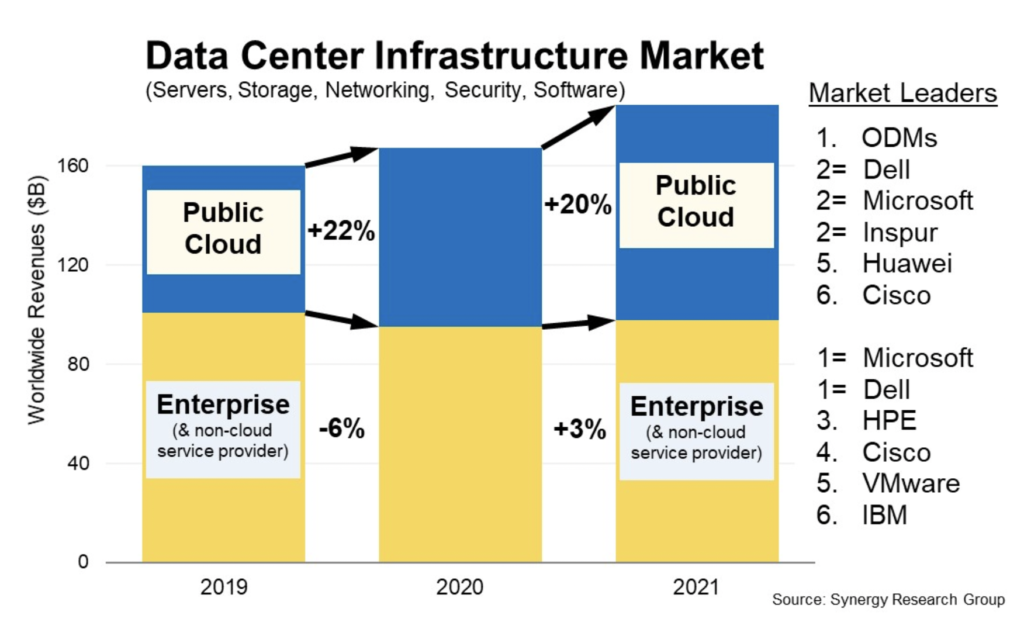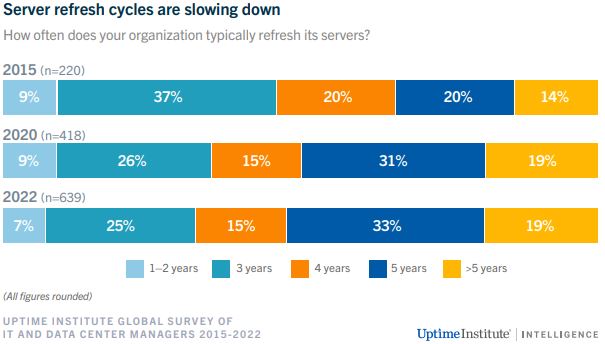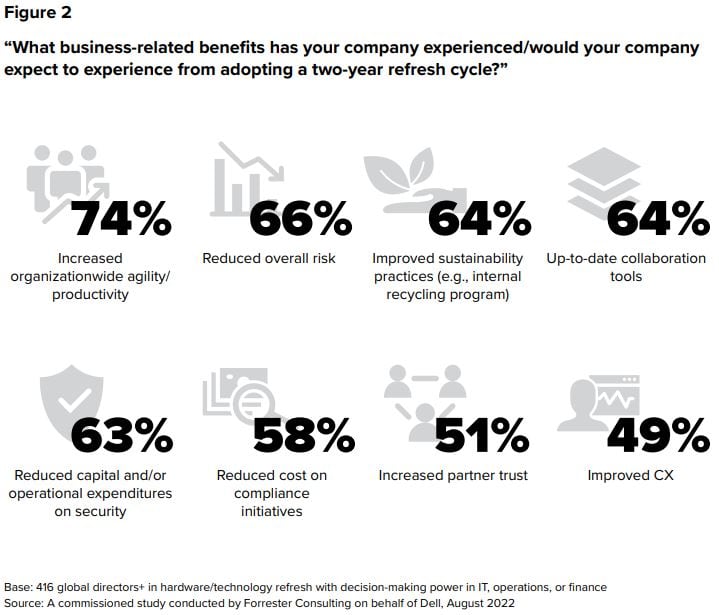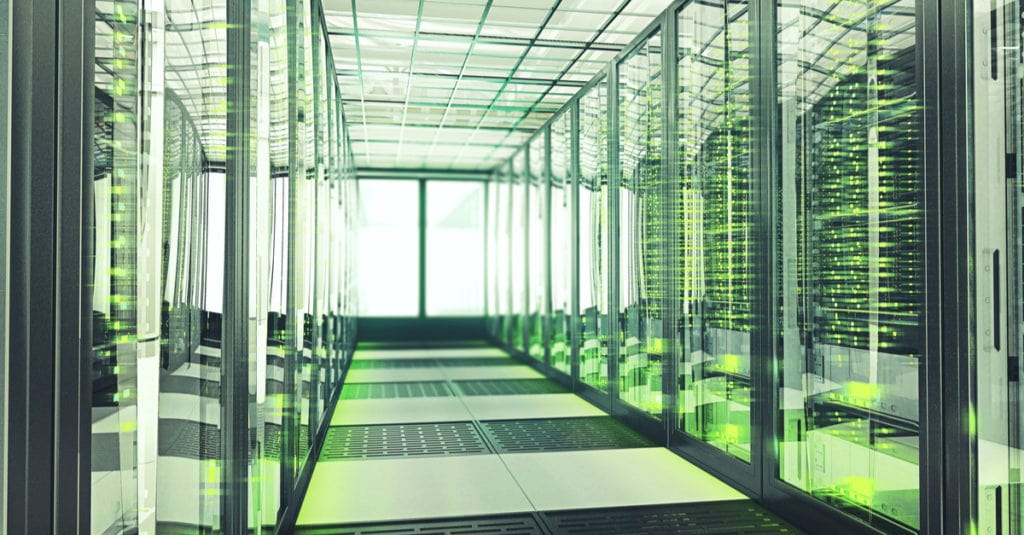From advice on decommissioning to insights around timing, get the latest analysis on hardware refresh cycles in the data center.
Getting the timing right on hardware refresh cycles in the data center is both a science and an art. With so many considerations to weigh, the decision on when to pull the trigger is always a tricky call for companies and their data center asset managers.
Here’s our analysis of current approaches and trends around hardware refreshes in the data center.
Major Trendlines in Hardware Refresh Cycles
Despite the accelerated growth of cloud computing in recent years, the on-premises data center is still alive and kicking— at least for now.
There’s little doubt that the pandemic hastened the adoption of cloud services among organizations large and small. A 2021 analysis from Synergy Research showed a sharp spike in cloud expenditure. This trend is set to continue, with hyperscale capacity tripling in the next six years.

As cloud adoption soars, on-prem as a share of critical IT load will shrink. But the picture is not as dire as it may look for on-prem spend, which has grown at a steady 6% CAGR since 2016. Corporate data center spending throughout 2021 was, despite the ravages of the pandemic, still comparable with two years beforehand.
Unsurprisingly perhaps, businesses continue to rely on traditional data centers for their mission critical workloads. According to 2023 research from the Uptime Institute, only 35% of organizations put mission-critical workloads into public clouds. The reason: companies are increasingly nervous about the data security public cloud services. Almost 42% of all companies keep mission-critical workloads off the cloud due to security concerns.
On-premises is here for the foreseeable future. This is despite the relentless (and highly successful) attempts by the cloud service providers to grow their market share.
Changing Attitudes toward Hardware Refreshes
It might be natural to think that the staying power of on-premises computing will drive more frequent hardware refreshes. Surely companies always want the latest and greatest technology to power their data centers?
In fact, the opposite may be true. Refresh cycles, according to Uptime Institute research, are broadly lengthening rather than shortening. In its 2022 data center survey, the most common time between refreshes was five years, compared with three years in 2015. That represented a significant shift in a relatively short space of time. According to the latest data, this shift has since become entrenched.

So what’s driving this lengthening effect? Uptime Institute suggests that a slowing in power usage efficiency (PUE) for data center hardware has blunted a major incentive for more frequent server refreshes. Average PUE plummeted from 2.5 in 2007 to 1.67 in 2014, but improvement has since stagnated, with an average PUA of 1.55 in 2022.

As efficiency gains slow, so do the financial motivations for replacing already expensive hardware. Moore’s Law is delivering increasingly diminished returns.
“It is this doubling in performance per watt that underpins the major opportunity for increasing compute capacity while increasing efficiency through hardware refresh. But in the past five years, it has been harder for Intel (and immediate rival AMD) to maintain the pace of improvement. This raises the question: Are we still seeing these gains from recent and forthcoming generations of central processing units? If not, the hardware refresh case will be undermined.”
Uptime Institute 2022 data center report
Industry Arguments for Hardware Refresh
Unsurprisingly, enterprise vendors remain eager to push hardware upgrade cycles.
Take Dell, which — in a Forrester report it commissioned in 2022 — warned of the opportunity costs of not upgrading equipment in a timely fashion.
“Security breaches and more flexible working styles are driving companies to rethink their approaches to device management and refresh. While the majority of respondents are pursuing a traditional three or four-year refresh, many are seeing the potential benefits of moving to an accelerated refresh model” the report authors stated at the time.

The report found that 66% of respondents experienced an overall security risk-reduction by adopting a two-year refresh cycle. Accordingly, the authors argued that two-year refresh was optimal for performance. The benefits in terms of security, employee experience, and sustainability “should lead to a more cost-effective device lifecycle overall” they advised.
Hyperscaler Refresh Cycles
While enterprise vendors like Dell advocate for more frequent refresh cycles, it’s important to watch what the hyperscalers are doing to properly gauge which way the wind is blowing.
Consider Microsoft. It currently operates 4 million servers (and counting) across its massive data center portfolio — a huge amount of data center equipment by any measure. Formerly on a four year refresh cycle, Microsoft CFO Amy Hood announced in 2022 that the firm will extend the life span of its servers to six years.
Also indicative is what Microsoft plans to do with its retiring server hardware. Similar to Google, Microsoft is deepening its commitment to circular economy practices. In 2020, Microsoft committed achieving a cloud hardware reuse rate of 90% by 2030. This is through a combination of repair management, reuse, and recycling. By 2023, they had achieved an 82% reuse and recycle rate for cloud hardware.
“Using machine learning, we will process servers and hardware that are being decommissioned onsite,” Microsoft president Brad Smith remarked in a statement from August 2020. “We’ll sort the pieces that can be reused and repurposed by us, our customers, or sold.”

Related Reading
Refresh cycles are just one way to make a datacenter more sustainable and cost-effective. See how data centers are taking circularity to the next level.
Data Center Management And The Circular Economy: Key Initiatives To Watch
Firms increasingly see a shift towards reuse as a sound move. One main conclusion of Uptime’s 2022 report was that sustainability pressures are growing. Of those surveyed, 63% expected data centers in their region to be subject to sustainability reporting requirements in the next 5 years. Then there’s the cost savings. Google reduced depreciation expenses by $2.6 billion when they extended their refresh from two to three years. Similarly, Amazon expected to save a billion in the space of a quarter by shifting to a five year server refresh cycle.
This trend toward repair and reuse will not only further lengthen the time horizon around hardware refreshes. It will also support the concrete expansion of a secondary market for used data center equipment that has been largely peripheral to this point. Think of it as circular hardware.
Planning your Hardware Refresh
Let’s be clear: the upsides of well-planned technology refreshes are real. Even within the context of lengthening refresh cycles, hardware needs to be replaced at some point.
While this is certainly true of compute capacity, the case is even more clear around storage. Businesses cannot ignore the relentless growth in data generation: unless you’re migrating data to the cloud, you need additional capacity on-premises to store it.
Disaggregated servers may help in this regard. Instead of replacing the entire server, update individual components — such as storage, memory or compute — within the unit instead.
“Disaggregated servers give data centers the ability to spend less time and money on refreshing servers so that they can refresh faster and take advantage of the latest technologies. For example, if a newer, higher-performing CPU is available, a data center operator can upgrade the CPU without upgrading the memory subsystem.
Super Micro 2021 Data Centers & the Environment Report
Asking the Right Questions
There’s certainly a lot to consider wen undergoing a hardware refresh. But don’t let that stand in your way. It makes sense to run a cost-benefit analysis against any proposed refresh. Questions to ask include:
- What are the performance and energy savings you expect to derive from the upgrade?
- Does your refresh plan sufficiently prepare your organization for future workload demands?
- What are the labor and capital costs associated with the work?
- How will you stage the work to minimize disruption to the operation?
- What is the value residing in the IT equipment you’re replacing?
- How can you claw back some of the investment in order to offset the upfront costs of the upgrade?
- What equipment can you redeploy internally, and what can you decommission and earmark for secure remarketing?
For hands-on support planning a hardware refresh in your data center, draw on the industry expertise of Horizon Technology and engage with a partner that knows how to make a difference on your behalf.
Related Articles
Here are five related resources to help you get a better handle around planning for server and storage refreshes:
- Knowing your data center hardware
- Accessing trusted support for your refresh needs
- Successfully managing a data center decommissioning
- Understanding the benefits of factory recertified drives
- Greening your data center hardware (while returning money to the bottom line)











